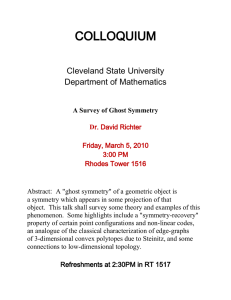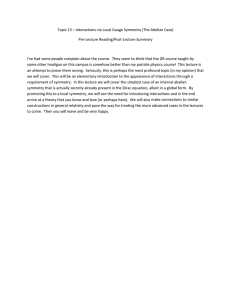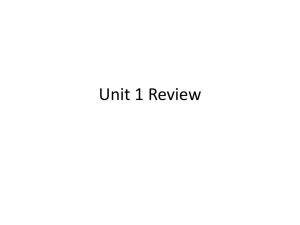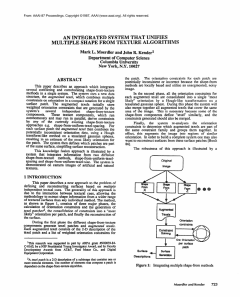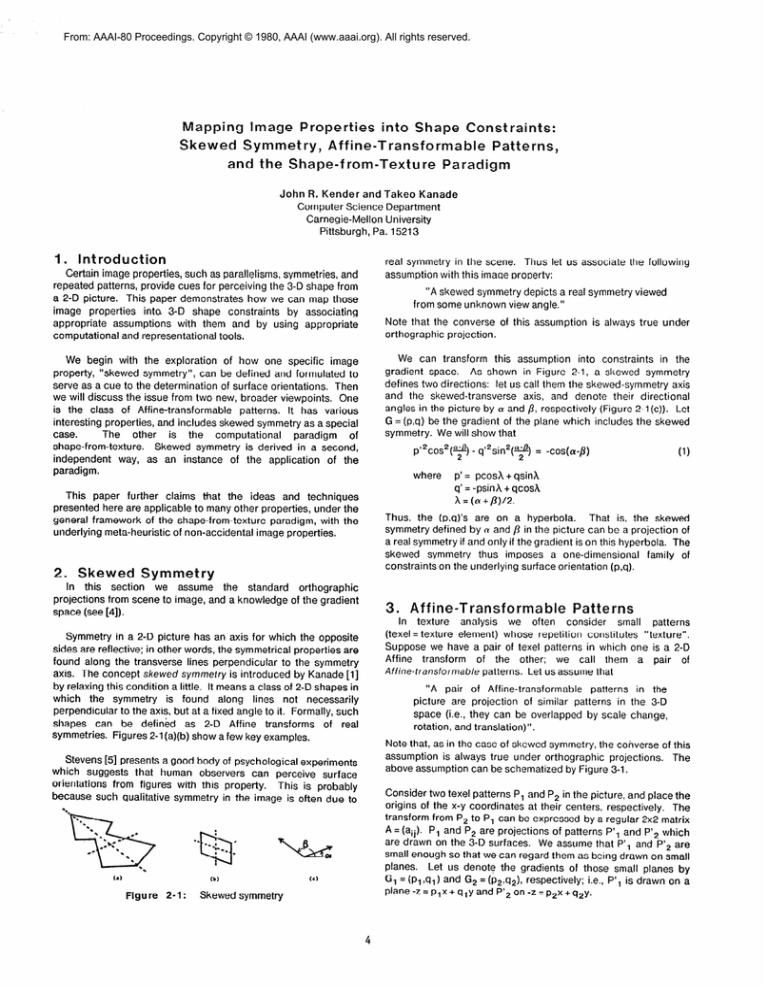
From: AAAI-80 Proceedings. Copyright © 1980, AAAI (www.aaai.org). All rights reserved.
Mapping Image Properties
into Shape Constraints:
Skewed Symmetry,
Affine-Transformable
Patterns,
and the Shape-from-Texture
Paradigm
John R. Kender and Takeo Kanade
Computer Science Department
Carnegie-Mellon
University
Pittsburgh, Pa. 15213
1.
Introduction
real symmetry in the scene. Thus let us associate
assumption with this image property:
Certain image properties, such as parallelisms, symmetries, and
repeated patterns, provide cues for perceiving the 3-D shape from
a 2-D picture. This paper demonstrates how we can map those
image properties
into 3-D shape constraints
by associating
appropriate
assumptions with them and by using appropriate
computational and representational tools.
“A skewed symmetry depicts a real symmetry viewed
from some unknown view angle.”
Note that the converse
orthographic projection.
p’*cos*(~)
where
This paper further claims that the ideas and techniques
presented here are applicable to many other properties, under the
general framework of the shape-from-texture
paradigm, with the
underlying meta-heuristic of non-accidental image properties.
Skewed
Symmetry
3.
- q’*sin*(y)
= -cos(a-/?)
(1)
p’= pcosX + qsinX
q’= -psinX + qcosX
h = (a + /3)/2.
Affine-Transformable
Patterns
we often
consider
small
patterns
In texture
analysis
(texel= texture element) whose repetition constitutes
“texture”.
Suppose we have a pair of texel patterns in which one is a 2-D
Affine
transform
of the other; we call them a pair of
Affine-transformable
patterns. Let us assume that
Symmetry in a 2-D picture has an axis for which the opposite
sides are reflective; in other words, the symmetrical properties are
found along the transverse lines perpendicular
to the symmetry
axis. The concept skewed symmefry is introduced by Kanade [l]
by relaxing this condition a little. It means a class of 2-D shapes in
which the symmetry
is found
along lines not necessarily
perpendicular to the axis, but at a fixed angle to it. Formally, such
shapes can be defined
as 2-D Affine transforms
of real
symmetries. Figures 2-1 (a)(b) show a few key examples.
“A pair of Affine-transformable
patterns in the
picture are projection of similar patterns in the 3-D
space (i.e., they can be overlapped by scale change,
rotation, and translation)“.
Note that, as in the case of skewed symmetry, the coiiverse of this
assumption is always true under orthographic
projections.
The
above assumption can be schematized by Figure 3-l.
Stevens [5] presents a good body of psychological experiments
which suggests that human observers can perceive surface
orientations
from figures with this property.
This is probably
because such qualitative symmetry in the image is often due to
Consider two texel patterns P, and P, in the picture, and place the
origins of the x-y coordinates at their centers, respectively.
The
transform from P2 to P, can be expressed by a regular 2x2 matrix
A = (aij). PI and P2 are projections of patterns P’, and P’, which
are drawn on the 3-D surfaces. We assume that P’, and P’, are
small enough SO that we can regard them as being drawn on small
planes.
Let us denote the gradients of those small planes by
G, = (~1 ,ql) and G2 = (p2,q2), respectively; i.e., P’, is drawn on a
plane-z=p,x+q,yandP’20n-z=p2x+q12y.
(b)
2-1:
is always true under
Thus, the (p,q)‘s are on a hyperbola.
That is, the skewed
symmetry defined by (Yand fl in the picture can be a projection of
a real symmetry if and only if the gradient is on this hyperbola. The
skewed symmetry thus imposes a one-dimensional
family of
constraints on the underlying surface orientation (p,q).
In this section
we assume the standard
orthographic
projections from scene to image, and a knowledge of the gradient
space (see [4]).
Figure
of this assumption
We can transform this assumption
into constraints
in the
As shown in Figure 2-1, a skewed symmetry
gradient space.
defines two directions:
let us call them the skewed-symmetry
axis
and the skewed-transverse
axis, and denote their directional
angles in the picture by (r and /?, respectively (Figure 2-l(c)).
Let
G = (p,q) be the gradient of the plane which includes the skewed
symmetry. We will show that
We begin with the exploration
of how one specific image
property, “skewed symmetry”, can be defined and formulated to
serve as a cue to the determination of surface orientations.
Then
we will discuss the issue from two new, broader viewpoints.
One
is the class of Affine-transformable
patterns. It has various
interesting properties, and includes skewed symmetry as a special
The
other
is the
computational
paradigm
of
case.
shape-from-texture.
Skewed symmetry is derived in a second,
independent
way, as an instance of the application
of the
paradigm.
2.
the following
Skewed symmetry
4
Now, our assumption
amounts
to saying
that
P’,
is
transformable from .P’, by a scalar scale factor u and a rotation
matrix R = (zynsz iz,“d,“,*). (W e can omit the translation from our
consideration, since for each pattern the origin of the coordinates
is placed at its gravity center, which is invariant under the
Affine-transform).
Thinking about a pattern drawn on a small
plane, -z= px + qy, is equivalent
to viewing the pattern from
directly overhead; that is, rotating the x-y-z coordinates so that the
normal vector of the plane is along the new z-axis (line of sight).
For this purpose we rotate the coordinates first bv cp around the
y-axis and then by 8 around the x-axis. We have the following
relations among v, 8, p, and q:
sincp = p/m
cosql = 1/J&i
sine =9/&7&i
c0se
knowing
either the original patterns
relationships (a and R) in the 3-D space.
(P’,
and
P’*)
or their
The Affine transform
from P, to P, is more intuitively
understood by how a pair of perpendicular
unit-length vectors
(typically along the x and y coordinate axes) are mapped into their
transformed vectors. Two angles (a and /I) and two lengths (T and
p) can characterize
the transform.
Components
of the
transformation matrix A = (aij) are represented by:
a,, =7cosa
a21 = Tsina
(2)
a12=Pcos/?
a2* = psi@
(3)
Let us consider the case that a and p are known, but T and p
are not. Using (3), eliminate T and p. Then, we obtain
= J;;T;-i/
(Pl cosa + q 1sinaNp, cosp + q, sir@) + cos(a-P) = 0
The plane which was represented
as -z= px +qy in the old
coordinates is, of course, now represented as -z’ =O in the new
coordinates.
which is exactly the same as the hyperbola
Let us denote the angles of the coordinate rotations to obtain
P’, and P’, in Figure 3-l by (cp, ,8,) and (‘p2,e2), individually. The
2-D mapping from P’i (xl-y’ plane) to Pi (x-y plane) can be
conveniently
represented by the following 2x2 matrix Tt which is
actually a submatrix of the usual 3-D rotation matrix.
. The
Shape-from-Texture
(1).
Paradigm
This section derives the same skewed-symmetry
constraints
from a second theory, different from the Affine-transformable
patterns.
The shape-from-texture
paradigm is briefly presented
here; a futler discussion can be found in [3].
Ti =( cyo -Si~W~“)
The paradigm has two major portions.
In the first, a given
image textural property is “normalized” to give a general class of
surface orientation constraints.
In the second, the normalized
values are used in conjunction with assumed scene relations to
refine the constraints.
Only two texels are required, and only one
assumption (equality of scenic texture objects, or some other
simple relation) to generate a well-behaved
one-dimensional
family of possible surface orientations.
Now, in order for the schematic diagram of Figure 3-1 to hold,
what relationships have to be satisfied among the matrix A = (at)),
the gradients Gi = (pilqi) for i = 1,2, the angles (pi, ei) for i = 1,2, the
scale factor u, and the matrix R ? We equate the two transforms
that start from P’, to reach at P,:
one following the diagram
counter-clockwise
P’,->P*->P, , the other clockwise P’,->P’,->P,.
We obtain
AT2
The first step in the paradigm is the normalization of a given
texel property. The goal is to create a normalized texture property
map (NTPM), which is a representational
and computational tool
The NTPM
relating image properties
to scene properties.
summarizes the many different conditions that may have occurred
in the scene leading to the formation of the given texel. In general,
the NTPM of a certain property is-a scalar-valued function of two
variables. The two input variables describe the postulated surface
orientation in the scene (top-bottom and left-right slants:
(p,q)
when we use the gradient space). The NTPM returns the value of
the property that the textural object would have had in the scene,
in order for the image to have the observed textural property. As
an example, the NTPM for a horizontal unit line length in the image
summarizes the lengths of lines that would have been necessary in
3-D space under various orientations: at surface orientation (p,q),
it would have to be m.
= T, aR.
By eliminating u and a, and substituting for sines and cosines
of pi and Bi by (2), we have two (fairly complex) equations in terms
of pi, qi, and the elements of A. We therefore find that the
assumption of Affine-transformable
patterns yields a constraint
determined solely by the matrix A. The matrix is determined by the
relation between P, and P, observable
in the picture: without
More specifically, the NTPM is formed by selecting a texel and a
texel property,
back-projecting
the texel through the known
imaging geometry onto all conceivable surface orientations, and
measuring the texel property there.
Figure
3-1:
In the second phase of the paradigm, the NTPM is refined in the
following way. Texels usually have various orientations in the
image, and there are many different texel types.
Each texel
generates its own image-scene relationships, summarized in its
NTPM. If, however, assumptions can be made to relate one texel
to another, then their NTPMs can also be related; in most cases
only a few scenic surface orientations can satisfy both texels’
requirements.
Some examples of the assumptions that relate
texels are: both lie in the same plane, both are equal in textural
CT/?= CT( coti -5ind >
Sind ~0x4
A schematic diagram showing the assumptions
on Affine transformable patterns.
5
formula under the substitution pcosS + qsin6 for p, -psin6
for q. We do similarly for the slope at -8.
measure (length, area, etc.), one is k times the other in measure,
etc. Relating texels in this manner forces more stringent demands
on the scene. If enough relations are invoked, the orientation of
the local surface supporting two or nrore related texels can be very
precisely determined.
The fact that the normalized
slopes are assumed to be
perpendicular in the scene allows us to set one of the normalized
values equal to the negative reciprocal of the other. The resultant
equation becomes
What we now show is that the skewed symmetry method is a
special case of the shape-from-texture
paradigm; it can be derived
from considerations of texel slope.
p2cos2&q2sin26
= sin*&cos*S
This is exactly the hyperbola
To normalize the slope of a texel, it is back-projected
onto a
The angle that the
plane with the postulated
orientation.
back-projected slope makes with respect to the gradient vector of
the plane is one good choice (out of many) for the normalized
slope measure. Under perspective, the normalized value depends
on the image position and camera focal length; under orthography
it is much simpler.
5.
cl211~dtl
q / [P/(1
lt is independent
for the skewed symmetry, the
and texture
analysis
can be
exploiting
image
of non-accidental
generalization
of
world, to exclude
Instances that can fall within this meta-heuristic
includes:
parallel lines in the picture vs. parallel lines in the scene, texture
gradients, and lines convergent to a vanishing point.
One of the most essential points of our technique is that we
related certain image properties to certain 3-D space properties,
and that we map the relationships into convenient representations
We explicitly
incorporate
assumptions
of shape constraints.
based either on the meta-heuristic or on apriori knowledge of the
world.
The
shape-from-texture
paradigm
provides
a
computational
framework for our technique.
In most part of our
Similar--though
more
discussion
we assumed orthography.
involved
and less intuitive--results
can be obtained
under
perspective projections.
The
f P2 + q*>1.
we used
patterns,
This provides
a useful meta-heuristic
for
properties: we can call it the meta-heuristic
image
properties.
It can be regarded as a
general view directions, often used in the blocks
the cases of accidental line alignments.
+ P2 + s*>1.
simplifies.
(1) with 26 =/l-a.
“Properties
observable in the picture are not by
accident,
but are projections
of some preferred
corresponding 3-D properties.”
This normalized value can be exploited in several ways.
Most
important is the result that is obtained when one has two slopes in
the image that are assumed to arise from equal slopes in the
scene. Under this assumptions, their normalized property maps
can be equated. The resulting constraint, surprisingly, is a simple
straight line in the gradient space.
Under
orthography,
nearly
everything
normalized slope of a texel becomes
= -cos26.
Conclusion
The assumptions
Affine-transformable
generalized as
Using the construction
in Figure 4-1, together with several
lemmas relating surfaces in perspective to their local vanishing
lines, slope is normalized as follows. Assume a slope is parallel to
the p axis; the image and gradient space can always be rotated
into such a position. (If rotation is necessary, the resulting NTPM
can be de-rotated into the original position using the standard
two-by-two orthonormal matrix.)
Also assume that the slope is
somewhere along the line y = ys, where the unit of measurement
in the image is equal to one focal length. Then, the normalized
slope value--the normalized texture property map -- is given by
Es - Ys(P2 +
qcosd
(4)
of Y,; in effect, all slopes are at the focal point.
This work is further .discussed
same title as this paper.
Consider Figure 2-1 (a). Given the angle that the two texels form
(/?-a), rotate the gradient space so that the positive p axis bisects
the angle. Let each half-angle be 6, so 6 = (/I-a)/2.
Calculating
the normalized value of either slope is obtained directly from the
normalized
slope
formula,
corrected
for
the
standard
displacement of + S and -6 respectively.
That is, for the slope at
the positive 6 orientation,
instead of formula (4), we use the
in a technical
report with
References
Kanade, T.
Recovery
of the 3-Dimensional
Single
Shape
of an Object
from
View.
Technical Report CMU-CS-79-153, Computer Science
Department, Carnegie-Mellon
University, Oct., 1979.
PI
Kender, J.R.
Shape
from
Texture.
PhD thesis, Computer Science Department,
Carnegie-Mellon University, 1980.
[31
Mackworth,
Interpreting
Artificial
[41
Figure
4-1:
A.K.
Pictures of Polyhedral
intelligence
4(2), 1973.
Stevens, K.A.
Surface Perception
Contour.
Back-projecting an image slope onto a plane
with gradient (p, q).
Technical
6
Scenes.
from
Local
Analysis
of Texture
Report AI-TR-512, MIT-AI, 1980.
and
a

